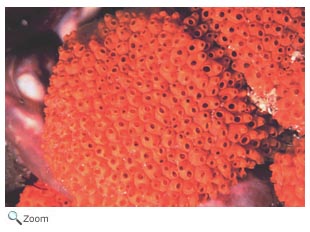Chordata - Vertebrates, Tunicates,
Lancelets
 At some point, all of the organisms in this phylum have a structure called a
notochord. A
notochord is a
flexible rod-like cord of cells that provides
the main support for the organism's body during its embryonic stage. In some organisms, like the tunicates, the notochord disappears in the organism's adult stage. In other organisms, like the vertebrates, the notochord is replaced or surrounded by the backbone in the organism's adult stage. At some point, all of the organisms in this phylum have a structure called a
notochord. A
notochord is a
flexible rod-like cord of cells that provides
the main support for the organism's body during its embryonic stage. In some organisms, like the tunicates, the notochord disappears in the organism's adult stage. In other organisms, like the vertebrates, the notochord is replaced or surrounded by the backbone in the organism's adult stage.
Chordates also have
pharyngeal slits. These are openings that connect the
pharynx or throat to the outside of the neck. In some primitive species, the slits are used to filter food out of the water. In other species, like fish, the pharyngeal slits have gills. In other species, like mammals, the pharyngeal slits are only present during the embryonic stage.
 Chordates also have a
dorsal nerve cord that runs down the length of the organism. The dorsal nerve cord has pairs of nerves that connect to the organism's muscles. In some organisms, the dorsal nerve cord expands into a brain at the top. Chordates also have a
dorsal nerve cord that runs down the length of the organism. The dorsal nerve cord has pairs of nerves that connect to the organism's muscles. In some organisms, the dorsal nerve cord expands into a brain at the top.
All chordates have a post-anal tail. A
post-anal tail is an
extension
of the body that runs past the
anal opening. In some species, like humans, this feature is only present during the embryonic stage.
The chordata phylum is divided into three groups or subphylums: lancelets, tunicats, and vertebrates.
|